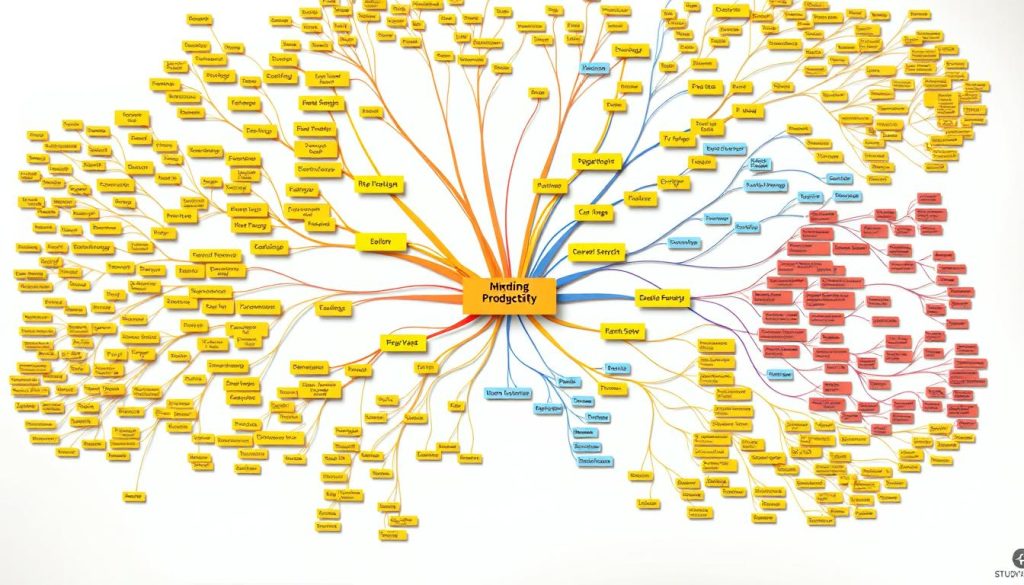Feeling overwhelmed by disorganized notes? We have a simple solution to boost your productivity! Using different colors to categorize information creates a visual map. This enhances understanding and retention.
This method is a game-changer for students and professionals alike. By using color-coded organization, you can find what you need fast. This saves time and reduces stress. Let’s dive into how to use this effective note-taking method!
Key Takeaways
- Improve your productivity with a simple, visual system.
- Enhance your learning experience with color-coded organization.
- Reduce stress by quickly locating the information you need.
- Transform your note-taking sessions into efficient, effective learning experiences.
- Boost your understanding and retention with a visual map of information.
The Science Behind Color-Coding
Color-coded notes work because of how our brains process colors. This knowledge helps us use color-coding to boost our productivity and learning.
How Colors Affect Memory Retention
Colors play a big role in how we remember things. They act as visual cues that help our brains sort and focus on information. Using different colors for different types of info makes it easier to remember.
Cognitive Processing and Visual Cues
Our brains love visual stuff, making color-coding a great tool. Colors get our brain’s visual cortex working fast, helping us remember better. This makes your notes more fun and easy to go over.
Research on Color and Productivity
Colors can really affect how productive we are. Using colors can lower stress and help us stay focused, making our work and study time more effective. The right colors can make a big difference in our productivity.
Using the science of color-coding can really help you do better in school or work. It makes learning and working more efficient. So, try using color-coding in your notes to see the difference for yourself.
Benefits of Using Color-Coded Notes
Color-coded notes offer many advantages, from better organization to improved focus. They make studying more fun and productive. This method is great for both students and professionals aiming to increase their productivity.
Enhanced Information Organization
Color-coded notes help you organize your study materials better. By using different colors for different topics, you can find what you need quickly. This visual approach makes it easier to review and remember information.
Faster Information Retrieval
Color-coded notes speed up finding information. The colors act as a visual guide, helping your brain process information faster. This way, you can study more efficiently and make the most of your time.
Improved Focus and Concentration
Color-coded notes also enhance your focus and concentration. They make your notes more attractive, keeping you engaged for longer. This is especially helpful during long study sessions or complex projects.
Stress Reduction Through Visual Clarity
The clear visual organization of color-coded notes also reduces stress. When your notes are well-organized and easy to read, you feel more in control. This leads to a more enjoyable study experience and better results.
| Benefits | Description |
|---|---|
| Enhanced Organization | Assigning colors to topics for better categorization |
| Faster Retrieval | Using colors as visual cues for quicker information access |
| Improved Focus | Making notes more engaging and visually appealing |
| Stress Reduction | Creating a clear and organized study environment |
Essential Supplies for Effective Color-Coding
Let’s explore the key supplies for color-coding. You’ll need various tools to organize and sort your notes.
Pen and Marker Options
Pens and markers are your main tools for color-coding. Choose vibrant colors and fine tips for accuracy. Faber-Castell and Sharpie are top choices.
| Tool | Best For | Recommended Brand |
|---|---|---|
| Pens | Detailed note-taking | Faber-Castell |
| Markers | Highlighting main ideas | Sharpie |
Highlighters and Their Effective Use
Highlighters are key for highlighting important info. Use different colors for different types of info.
Digital Tools for Color-Coding
If you like digital notes, apps like Evernote and OneNote are great. They let you color-code and sync notes across devices.
Budget-Friendly Alternatives
You don’t need to spend a lot to start color-coding. Look for cheap options at local stores or online.
Creating Your Personal Color-Coded Notes System
Make your note-taking better with a color-coding system that fits you. A system made just for you can really help you work better and study smarter.
Identifying Key Categories for Your Notes
First, figure out the main topics in your notes. Students might have “lectures,” “readings,” and “assignments.” Workers might have “meetings,” “projects,” and “industry news.” Change your categories as you see fit.
Assigning Colors Meaningfully
After picking your categories, pick a color for each. Use red for important stuff, green for new ideas, and blue for extra details. It’s important to stick to it and choose colors that mean something to you.

Creating a Color Key Reference
A color key is key to keeping your notes consistent. It can be a small legend on each page or a special page in your notebook. Keep it nearby and check it often.
Testing and Refining Your System
As you start using your system, be ready to tweak it. You might find some colors work better than others or need new categories.
“The best color-coding systems are those that evolve with your needs.”
Check your system often and make changes to keep it helping you. This way, your notes will stay organized and fun to make.
By following these steps, you can make a color-coded notes system that boosts your organization and makes note-taking fun and effective.
Step-by-Step Guide to Implementing Color-Coded Notes
Let’s dive into the step-by-step guide to using color-coded notes. This method might seem hard at first. But, breaking it down into simple steps will help you create a system that boosts your productivity.
Preparing Your Materials
First, collect all the materials you need. This includes pens, highlighters, notebooks, or digital tools. Make sure you have many colors to mark different types of information. Organize your materials so they’re easy to find as you start your system.
Setting Up Your First Color-Coded Page
Start by setting up your first page. If you’re using a notebook, create a key or legend. This explains what each color means. For digital tools, set up a template with your color system. This first step is important because it will guide all your future notes. Make sure it’s clear and easy to understand.
Maintaining Consistency Across Notes
Being consistent is crucial for effective color-coded notes. As you take more notes, keep using the same color categories. You might need to check your key or legend sometimes. But, with time, using colors will become natural, and you’ll quickly organize information.
Reviewing and Reinforcing with Colors
It’s important to regularly review your notes. Use your color system to spot important information, patterns, or areas to focus on. This helps you remember and connect different pieces of information. By reviewing and reinforcing your notes with colors, you’ll understand better and be ready for exams or projects.
By following these steps, you’ll be on your way to a color-coded notes system that improves your productivity and learning. Remember, the main thing is to stay consistent and review regularly.
Color-Coding for Different Learning Environments
Color-coding is not just for one type of learner. It’s a flexible tool for many settings, from classrooms to work. By adjusting your color-coding, you can boost learning and productivity in various places.
Classroom Note-Taking Strategies
In class, color-coding helps separate main ideas from details. You might use one color for the main topic and another for subtopics. This makes it simpler to study and remember for exams.
Think about using different colors for:
- Key terms and definitions
- Examples and illustrations
- Questions to ask the instructor
Self-Study Optimization
Color-coding is great for studying alone. It helps organize your study materials better. Use colors to sort information like concepts to grasp, formulas to remember, or tasks to do.
Make a color key to use while studying. For instance:
| Color | Category |
|---|---|
| Red | Important formulas |
| Green | Key concepts |
| Blue | Tasks to complete |
Professional Meeting Notes
In work meetings, color-coding improves your notes. It highlights action items, decisions, and key points. This helps you remember tasks and important meeting details.
For example, use:
- Yellow for action items
- Pink for decisions made
- Green for follow-up tasks
Research and Complex Projects
Color-coding is key for complex projects or research. It helps manage different parts or sources. Use colors to distinguish between data sets, theories, or methods.
“The use of color in note-taking and organization can significantly enhance cognitive processing and memory recall, making it an invaluable tool for complex research projects.”
Color-coding in research organizes your findings and ideas. It makes spotting patterns and connections easier.
Digital Color-Coding Techniques
Digital tools are changing how we take notes. Color-coding can make us more productive. These tools let you pick colors that fit your needs.
Note-Taking Apps with Color Features
Evernote and OneNote are great for color-coding notes. You can highlight important stuff, sort notes, or see how you’re doing.
PDF and Document Annotation
Color-coding is also useful for annotating digital documents. Adobe Acrobat lets you highlight PDFs with colors. It makes documents easier to read and check.
Spreadsheet and Database Organization
Color-coding helps organize spreadsheets and databases too. You can color-code cells based on certain criteria. It makes data easier to sort and understand.
Syncing Physical and Digital Systems
Digital color-coding lets you keep your notes consistent. Whether you’re using an app or writing by hand, your notes will look the same.
| Tool | Color-Coding Feature | Platform |
|---|---|---|
| Evernote | Note highlighting | Web, Mobile |
| Adobe Acrobat | PDF annotation | Desktop |
| Google Sheets | Cell coloring | Web |
Digital color-coding makes your work flow better. It helps you stay organized and work faster. Whether you’re studying, working, or learning new things, these tools can help you reach your goals.
Advanced Color-Coded Notes Strategies
Take your note-taking to the next level with advanced color-coding strategies. Once you’ve learned the basics, explore more techniques to boost your productivity and learning.
Mind Mapping with Color-Coding
Mind mapping is a great way to organize and connect ideas. Adding color to your mind maps makes them visually stunning. Use red for main ideas, blue for details, and green for related tasks or questions.

Cornell Method Enhanced with Colors
The Cornell method divides your paper into sections for cues, notes, and summaries. Adding color makes your notes more effective. Use colored pens to highlight key terms in cues or to distinguish main ideas from details.
- Use a specific color for headings and key terms.
- Employ different colors for different types of information (e.g., definitions, examples, questions).
- Highlight summaries or key takeaways in a distinct color.
Bullet Journaling with Color Systems
Bullet journaling is flexible and creative, enhanced by color-coding. Use colored pens, markers, or highlighters for visually appealing layouts and to track information.
Some ideas for incorporating color include:
- Using a color-coded key to differentiate between task types (e.g., work, personal, urgent).
- Creating a color-coded calendar to track appointments or deadlines.
- Employing different colors for various collections or trackers (e.g., mood, habits, expenses).
Time Management Integration
Color-coding can also boost your productivity by integrating with time management. Use different colors for different time blocks or task categories. This visual approach helps you quickly identify priorities and manage your time better.
By combining these advanced color-coded notes strategies, you can create a powerful system. It enhances your learning, productivity, and organization.
Troubleshooting Common Color-Coding Challenges
Color-coding can be a big help, but it comes with its own set of problems. Let’s work through them together! When you start using color-coded notes, you might run into a few common issues. But don’t worry, there are easy fixes for these problems.
Dealing with Color Overwhelm
Feeling overwhelmed by too many colors? It’s time to make things simpler! Start with 3-5 core colors for your main categories. You can always add more later if you need to. Focus on the most important information and group similar data together.
Adjusting for Colorblindness
Colorblind or have friends who are? Don’t worry, you can still use color-coding. Use different shades or textures to tell categories apart. You can also use symbols or abbreviations with your colors to include everyone.
Recovering from Inconsistencies
We’ve all been there – our color-coding starts strong but then gets messy. To get back on track, check your color key and make changes if needed. Consistency is key, so take a few minutes to review and refine your system.
When to Simplify Your System
If your color-coding system is getting too complicated, it’s time to simplify! Take a step back and see what’s working and what’s not. Streamline your categories and colors. And don’t be afraid to start fresh if needed.
Conclusion: Elevating Your Productivity Through Color
Using a color-coding system can really boost your productivity and make learning better. We’ve looked into the science behind it, its benefits, and how to make a system that fits you.
When you start using color-coded notes, you’ll see better organization and quicker access to information. This method is great for students and professionals alike. It helps you reach your goals faster.
So, why wait? Start using color-coded notes today and see your productivity jump! With a bit of creativity and practice, you can make the most of color-coded notes. This will take your learning to new heights.

